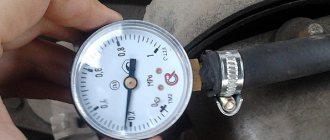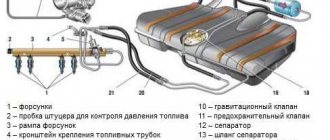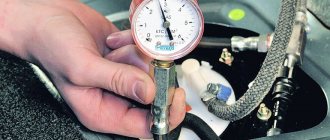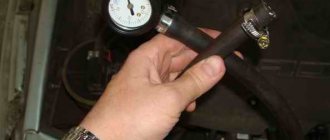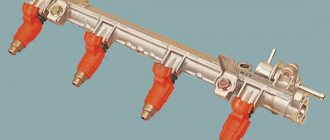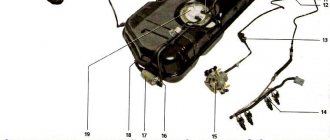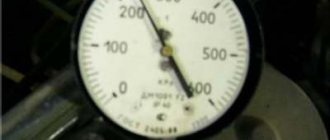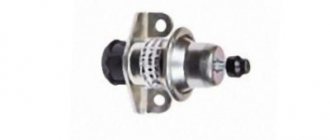A little theory of the issue. We understand that: 1. The pump must produce a certain fuel pressure when the engine is running. If this is not the case, then either the filters are clogged or the pump is on its way. Both are important to understand. Otherwise, power begins to be lost and the engine stalls. The fuel pump motor can jam at any time if it starts to “die”. 2. After stopping the engine, the pressure must be maintained at a certain level for a certain time - otherwise it may not start well. If not, the check valve in the pump is leaking. 3. The pump must produce a certain pressure - if you simply measure the pressure from the pump - without running the engine. Also shows the status of the filters and the status of the pump.
To check the pressure, at the service center, a fuel pressure gauge is connected to the gap in the fuel line from the pump to the ramp, and checked in different modes.
You can make it relatively inexpensively on your own and then use it if necessary. It is especially important for long runs to monitor the condition of the pump and filters in the tank.
What you will need:
set of parts
Pressure gauge for VAZ (oil + gasoline) (FuelMer PLUS) =
1000
rub. THIS IS the “PLUS” option - it’s interesting because by unscrewing the gasoline fitting, you can use it to check the oil pressure. To do this, you need to screw in the hose instead of the oil pressure sensor. I haven't checked yet whether the thread will fit. You may need an adapter.
Clarification. This pressure gauge has a gas fitting with a rare internal thread. This is exactly the thread on the test fitting in the injection VAZ. Therefore, a special adapter-fitting is needed. You can’t buy it just like that, only where they sell hydraulic equipment.
Adapter - fitting 7/16-20 UNF (this is the thread designation) = 26
rub. Purchased from LEOTEK
Gasoline filter VAZ 2104-07 = 100
r or used. You only need the fittings from the filter. There are no used ones, so we buy the cheapest one. Cut off the fittings and flare the ends a little.
Fittings for VAZ gas filter
You can grind out the required fitting. Drawing with dimensions of the fitting for quick release - see. below in the comments.
Fuel system connector “Y”-shaped VAZ-1118 = 75
R.
Clamp 4x 25
R
Petrol hose 1m = 50
rub.
We assemble the structure.
Finished design
The fitting should be secured so that there is space left when connecting.
So secure the fitting in the hose.
During assembly, this pin must be removed from the pressure gauge fitting. In a VAZ, it presses the spool, but we don’t need it.
Measurement procedure. 1.Remove the fuel pump relay and start it (it will stall). This will relieve the pressure in the system.
Remove the fuel pump relay.
2. To measure, remove the fuel line from the ramp. Place a cloth.
You need to take your car to a repair shop and pay 500 rubles. Or you can purchase a fuel pressure gauge and adapter for about 1,500 rubles and do this whole operation yourself. And you can also farm! More details below.
The video below measures the pressure in the fuel rail using a conventional tire pressure gauge:
Checking the pressure in the fuel system of the VAZ 2115
The pressure in the fuel system of the VAZ 2115 is one of the important parameters when diagnosing a car.
The behavior of your car in different modes depends on this parameter. The main signs by which you can determine the presence of malfunctions in the fuel system:
- “Trippling” of the engine or interruptions in operation.
- The idle speed fluctuates, the engine stalls at idle speed.
- Excessive fuel consumption.
- Increased CO content in exhaust gases.
Confirmation (or refutation) of the assumption that the vehicle’s fuel system is faulty is possible after checking the pressure in it.
To measure the pressure in the fuel system, you can buy a special fuel pressure measuring device. This is a ready-made kit consisting of a fuel pressure gauge, adapter and drain. The second option is to measure the fuel pressure at a service station. There is an option to check the pressure yourself.
Checking the pressure in the VAZ 2115 ramp in your garage does not require special devices. To check the pressure you will need a regular mechanical pressure gauge. Moreover, if the pressure gauge has a scale, for example, up to 16-20 atm., the result of measuring the pressure in the fuel system of the car can give a large error. This is due to the fact that for fuel the limit is much lower and amounts to 5-7 atm. It is correct to check the fuel pressure with a pressure gauge with a maximum value of 10 atm. (ideally 6-7 atm.). You also need to have a fuel (or oxygen) hose with a diameter of 9 mm, tow (to ensure a tight connection) and clamps.
To make a device under the pipe, we wind tow, put on an oxygen hose and tighten it with clamps.
Before starting to measure pressure, it is very important to make sure that the fuel system is intact and that there is no depressurization, otherwise your measurements will not be accurate.
Preparatory work
We place the pressure gauge on a previously prepared rag, and the preparatory work can be considered completed.
Measurement procedure
Before you start working, you can try to relieve the pressure in the fuel system. To do this, remove the fuel pump fuse (which is located on the right side of the panel, under the front passenger’s left foot - approx.). Where 3 relays and 3 fuses are located. In the photo below it is located under the number “5”. After removing the fuse, turn on the ignition and check by ear that . We start the car and wait for the engine to stall.
Additional block
- After everything is ready, we check the already attached end of the pressure gauge with the hose for a secure connection.
- Next, start the engine and look at the readings that appear.
Thus, we diagnose the results that appear and compare them with the results of the norm.
After all the work has been done, unscrew the hose with the pressure gauge, screw in the spool and return everything to its original state.
Note!
The peculiarity of measuring pressure using a pressure gauge is such that its initial value on the scale has a certain inaccuracy. That is, when the air analogue has a measurement period of 15-20 atmospheres, and for fuel control the required maximum value is 5-7 atmospheres, then all measurements taken will have an error equal to the initial values on the device. Therefore, pressure testing should be carried out on a pressure gauge with maximum values of up to 8 atmospheres.
We measure the pressure in the system without a check valve
If it happens that your engine does not have a check valve, then you need to know that in such a ramp there is a constant pressure from 3,6
up to
4.0
atmospheres. But the order of measurements in general is completely similar to what is described above.
Preparatory stage when checking the pressure in the fuel system of the VAZ 2115
- Open the hood and turn off the ignition.
- Unscrew the plastic cap from the fuel frame (if it has not been unscrewed for a long time, you may need pliers).
- If the car has just been turned off, the gasoline in the ramp is still under pressure. By pressing the spool with the cap from the wheel, release the pressure (after laying down a rag or placing some kind of container for residual fuel). Unscrew the nipple.
- Connect the hose of the mounted pressure measuring device to the fitting and secure it using a clamp.
The pressure in the fuel system is checked in four different operating modes of a car engine:
- with the ignition on
- at idle
- with the tube removed from the fuel pressure regulator (RDT)
- with a pinched return line.
- when the ignition is on, the pressure should be about 3 atm. (not less),
- at idle speed - about 2.5 atm.,
- with the RTD tube removed - about 3.3 atm.,
- with a pinched drain pipe (return) - about 7 atm.,
- when adding gas, the pressure increases to 3 atm, then drops to 2.5 atm.
How to remove the fuel rail of VAZ 2114, 2115 injectors - step-by-step instructions
1. First, you need to relieve the pressure in the fuel system; to do this, you need to turn off the fuel pump. To quickly turn off the fuel pump, simply remove the fuse that is responsible for this device from the socket in the fuse block. Next, you need to start the engine and let it run until it stalls. If you don’t want to go to the fuses, then you can try to turn off the power to the fuel pump in another way, for example, by disconnecting the fuel pump power supply.
2. Next, turn off the ignition.
3. Disconnect the negative terminal of the battery.
4. Disconnect the air receiver hose, as well as the vacuum hose from the pressure regulator.
5. Using a wrench set to “17” (some have a wrench set to “22”), unscrew the fittings and move the tubes to the side.
6. Then disconnect the fuel rail power wires.
7. Next, remove the clamping bar securing the fuel pipes.
8. Take the hexagon at “5” and use it to unscrew the two bolts securing the fuel rail.
9. Remove the injectors from their sockets, while slightly pulling the ramp along the axis.
10. Now you can remove the fuel rail from the car. Be extremely careful and careful not to damage the contacts of the injector connectors and sprayers. Make sure that nothing, such as dirt or dust, gets into the channels or fuel lines.
11. When unscrewing the union nut, hold the fitting using a second wrench.
12. Cleaning the ramp from dirt should be done exclusively with a special liquid for cleaning fuel cells (ABRO, WD-40).
This completes the removal procedure, all that remains is to carry out repair work, replace faulty parts and reassemble everything in reverse order. Thank you for your attention, see you again at VAZ Repair!
Checking the pressure in the fuel rail of VAZ 2115
The task of the fuel system is high-quality, timely and complete supply of gasoline to the engine, as well as storage and purification of fuel.
Structurally, the system consists of a fuel filter, injection system, fuel pump, tank and other elements connected by conductors.
In this case, the main function is performed by the fuel pump - it creates the necessary pressure in the fuel rail. If it decreases, serious malfunctions in engine operation are possible.
Why is this device needed?
The regulator, responsible for maintaining normal fuel pressure in the system, is in direct interaction with the power unit. According to its location, it can be located in the fuel tank or in the rail (this is where you will be able to find the regulator if you have an injection VAZ-2115). The reason for the failure of this element is often the low quality of gasoline. If you fill up at gas stations with greatly reduced prices, then it is not surprising that very soon the regulator will fail.
The fuel flows through the injectors to the intake manifold, and it is important that its pressure does not change at this moment. The regulator measures the volume of fuel required for engine operation, and also monitors the pressure in the fuel rail and intake manifold.
The main task of the RTD is to maintain the pressure difference at the same level, as well as monitor the indicators.
Symptoms of a problem
As a rule, checking the pressure in the fuel rail is required in the following cases:
- If malfunctions occur in the operation of the power unit at XX. In such a situation, the car may stall at the most unpredictable moment (even at a traffic light);
- the motor begins to stall, obvious instability appears in its operation;
- Significant excessive consumption of gasoline is noticeable. Consumption can generally increase by 30-50%;
- the volume of carbon monoxide in the exhaust increases.
This problem may “pop up” during inspection at stationary points and lead to a serious fine.
Please note that the symptoms we mentioned can also be caused by other problems - a clogged filter in the fuel system, a defect (malfunction) of spark plugs, bad fuel, and so on.
But if the initial inspection does not produce results, and the ECU does not generate errors, then checking the pressure in the ramp is mandatory.
Checking the pressure in the fuel rail of VAZ 2115
To take measurements, you do not need to go to a service station - do everything yourself. All you need to do is take a few simple steps. Find (buy) the necessary equipment.
To check you will need:
- Pressure gauge with a limit value of 8-10 atmospheres. It makes no sense to use a device with a larger scale due to the large error. The readings of such a pressure gauge will be distorted (especially if the pressure in the system is very low);
- a small piece of hoses with a diameter of 8-9 mm;
- tow (you can buy the most common product that is used in plumbing repairs).
From the materials listed above, make your own pressure measuring device. If there is no desire to “handicraft”, then you can buy a ready-made device (but here you will have to spend money).
What pressure should be in the fuel system
Take measurements in four modes (while recording what pressure in the fuel rail the pressure gauge shows):
- When turning the key in the ignition. In this case, the pressure should be about three atmospheres (not lower);
- when the engine is running at idle. The device should show about 2.4-2.5 atmospheres;
- when removing hoses and pressure regulator. In this mode, the pressure gauge readings should be around 3.2-3.3 atmospheres;
- when squeezing the drain hose. If the ramp is working properly, then the pressure should reach 7-8 atmospheres;
- when you press the accelerator pedal, the pressure gauge readings should jump to three atmospheres, and then drop to a level of 2.5.
Analyze possible problems in the system. Turn off the car and watch how the pressure gauge readings change. If the fuel rail is intact, then the readings should not fall below 0.7 atmospheres.
If the pressure drops to “0”, then the pressure regulator is most likely faulty. In such a situation, there is only one way out - the unit must be removed and replaced. At best, you can get by installing a new check valve on the fuel pump engine.
Raise the speed to 2800-3000 and carefully watch the movement of the needle. If the pressure decreases, then we can talk about a clear malfunction of the unit we are interested in.
If the pressure in the system takes a very long time to build up, then there may be two reasons - the fuel filter is too clogged or the coarse mesh is clogged.
In a situation where all assumptions remain unconfirmed in practice, you cannot do without high-quality diagnostics.
Here you will need to check a whole range of sensors - mass air flow sensor, air flow sensor and air pressure sensor. In addition, it would not be superfluous to measure the engine compression.
That's all. Before checking the pressure in the fuel rail, be sure to read the instructions, stock up on the necessary equipment and find out what parameters are normal for a “healthy” device.
Therefore, do not panic if the symptoms described above appear, but simply take a series of simple measurements. This will save you money, nerves and maintain the functionality of the car.
How to check fuel rail pressure yourself
This procedure will require a pressure gauge, the maximum value of which is 7-10 atmospheres. It is not recommended to use a more powerful pressure gauge, since the error when measuring a small pressure will be too large.
You also need to have a hose with an internal diameter of 9 millimeters and tow used for plumbing work (it can be used to ensure a tight connection). After this, all joints should be strengthened with special clamps. If possible, you can facilitate and speed up this process by using a ready-made device for measuring pressure in the ramp
.
Be careful!
Before checking the pressure of the fuel system, you need to make sure that it is intact and there is no depressurization, otherwise the measurements will be inaccurate. First of all, you need to open the hood, then turn off the ignition.
- Find the injector fuel rail.
- Remove the fuel pressure fitting plug and unscrew the nipple using a spool valve.
- Using rags and containers, remove any remaining fuel. Be careful to avoid contact with eyes.
- Connect the device hose to the fitting and secure it using the same clamp.
The pressure that should be in the fuel system:
- at the moment the ignition is turned on - at least 3 atmospheres;
- with idle speed - about 2.5 atmospheres;
- with the fuel pressure regulator tube removed, approximately 3.3 atmospheres;
- when adding gas, the pressure should increase to 3 atmospheres and drop to 2.5.
- After fuel enters the systems, turn off the ignition and monitor the pressure gauge readings. If the ramp is working properly, the pressure should be about 0.7 bar, and then stabilize at this mark.
- If the pressure drops to zero, this is a sign of a faulty fuel pressure regulator (FPR). It will be necessary to remove and replace it or install a new check valve for the fuel pump motor.
- Raise the rpm to 3000, watching the pressure gauge needle. If the arrow goes down, there is a problem with the fuel pump.
- If the fuel pump does not provide the required pressure, the strainer is probably clogged, and maybe the fuel filter of the pump is clogged.
- If the above signs are not confirmed, it is necessary to check the TPS, IAC, mass air flow sensor, and engine cylinder compression.
HOW TO CHECK THE FUEL SYSTEM?
Let's connect the pressure gauge to the fuel rail. With the fuel pump turned on and the engine not running, the pressure should be 2.8-3.2 atmospheres. If the engine is idling, the pressure should drop to 2.2-2.5 atmospheres. When over-gassing, the pressure gauge needle should deviate into the zone of 2.8-3.2 atmospheres.
Now let's check the operation of the injectors. With the engine not running, we will create the required pressure in the ramp (2.8-3.2 atmospheres), after which, using diagnostic equipment, we will apply a series of test pulses to the first injector, monitoring the change in pressure. The above procedure must be carried out for all injectors. The pressure drop should be the same in all cases. If the results of checking the fuel pressure correspond to those described above, the fuel supply system is working properly.
What will happen if the fuel pressure in the rail is low (less than 2 atm.) or high (more than 4 atm.)? The amount of fuel injected will change in proportion to the pressure deviation from the norm. In other words, the air-fuel mixture will become lean or rich.
It will be especially painful in engine control systems without oxygen sensor feedback, since the controller does not know about the malfunction and continues to calculate the fuel supply for a normal fuel pressure value. In control systems with an oxygen sensor, the controller can compensate for changes in the composition of the air-fuel mixture, but only within reasonable limits.
If the fuel pressure is incorrect, problems arise with starting the engine, dips appear when the vehicle moves, and fuel consumption increases.
We measure the pressure in the fuel system (ramp) of a VAZ 2114: a pressure gauge to help
The car is not always in good working order; it happens that it stops moving normally. The engine runs intermittently, jerks, and sometimes the car does not start at all. The cause may be a clogged fuel filter, a non-working pressure regulator, or a faulty electric pump located in the gasoline tank. To find out all these faults, you need to measure the pressure in the fuel line.
Measuring pressure in the fuel system
Fuel pressure sensor VAZ 2114
The injection fuel intake into the VAZ 2114 ensures reliable operation of all components, ease of starting, and so on. For proper operation of the injector, fuel must be supplied at a certain pressure.
The pressure in the fuel system is pumped up by a special fuel pump, and it is regulated by an RTD, which, by the way, is what today’s article is about.
This article talks about the VAZ 2114 RTD, its design, purpose, signs of malfunction and how to replace it yourself.
Purpose of RTD
The fuel pressure regulator (FPR) is designed to regulate fuel to the limits required for proper operation of the internal combustion engine. This part on VAZ cars is completely mechanical and does not contain any electronics.
The main task of the RTD is to keep the fuel at an acceptable pressure and release it when the pressure reaches a peak. When a part fails, interruptions in the operation of the internal combustion engine are observed.
Design
The regulator includes a check valve that opens when exposed to excess pressure. The RDT has two outputs, forward and reverse. The fuel pump pumps fuel into the direct line, since the fuel pump pumps fuel continuously, therefore, when a certain pressure value is reached, the RTD valve opens and excess fuel is discharged into the return line, which is connected to the tank.
PRESSURE IN THE FUEL LINE VAZ 2114
The pressure in the fuel line of an injection engine is an important parameter - if it is low, normal injection by injectors into the cylinders of an internal combustion engine (ICE) will not be ensured. And its high degree is also dangerous - fuel can flood the entire engine compartment, and then a fire will occur.
Car owners may have a question about how to check the pressure in the fuel rail, within what limits should the readings be, what is used to check it, and how to determine what may be faulty in the fuel line? So, in order.
First you should know how the fuel system (TS) works and what elements it consists of. The vehicle includes (elements in order, starting from gasoline intake to its direct injection):
- Gas tank (in the VAZ model 2114 it is located under the bottom of the trunk);
- Electric fuel pump (located in the gas tank);
- Coarse filter (represents a mesh that is located on the intake part of the pump);
- Fine filter (located immediately after the gas tank, located below the trunk, between the rear of the muffler and the fuel tank);
- Fuel rail or rail (TR), it distributes gasoline among the cylinders, it can be steel, aluminum or plastic;
- Injectors (there are four on model 2114);
- Fuel pressure regulator (it maintains the required gasoline pressure in the system for normal injection through the injectors into the cylinder).
All elements are connected to each other by a fuel line, and in the entire chain, after the pressure regulator (RDT), there is also a return hose through which excess gasoline is discharged into the tank. After the ignition is turned on, fuel passes through the system to the injectors (therefore, there is pressure in the system even when the ignition is on), and when the engine starts, the electronics send a command to the injectors, and gasoline enters the cylinders.
HOW AND WHAT TO CHECK THE PRESSURE IN THE VEHICLE
They check the pressure in the fuel rail of the VAZ 2114 with a pressure gauge - it is most convenient to connect it on the ramp, and not somewhere else in the line. At the rear of the ramp, in the direction of travel of the car, there is a fitting with a thread and a valve, closed with a plastic cap. When measuring, the pressure gauge adapter is screwed onto the fitting. The pressure gauge is easy to assemble yourself. For this you will need:
- The measuring device itself with an arrow - a tire pressure gauge with a maximum reading limit of 6 to 10 kgf/cm² is suitable;
- A piece of gasoline hose 50-70 cm long;
- A fitting for checking the pressure, which will be screwed into the ramp;
- Two clamps.
We assemble all the elements, tighten the clamps, and the pressure gauge is ready for use. That's it, now you can take measurements. To do this you will need tools:
- Wheel valve cap.
- Thin screwdriver or metal pin;
- A wrench with a fitting size (usually 17 mm):
- Pressure gauge.
To measure the pressure in the fuel rail, you need to:
- Turn off the engine, turn off the ignition;
- unscrew the cap, relieve pressure in the VAZ 2114 fuel rail by pressing the valve with a thin screwdriver;
- Unscrew the spool with the valve using the wheel valve cap. A rag will come in handy - when you dump it, fuel will spray out of the valve. To relieve pressure, you need to press the valve smoothly, releasing the pressure;
- secure the pressure gauge fitting with a wrench to the rail. Now you can start the internal combustion engine and measure the pressure in the fuel rail.
Signs of a fuel system malfunction
Low or excessive pressure in the fuel rail leads to the following consequences:
- unstable engine operation;
- not smooth idle;
- engine tripping;
- increased consumption;
- power drop;
- the engine stalls at idle;
- increased CO content in exhaust gases.
If you encounter one of these problems, and ECU diagnostics do not give any results, then the first thing you need to do is measure the pressure in the fuel system.
The pressure in the fuel rail is measured according to the same principle as in the tires.
Purpose and principle of operation of the VAZ 2114 fuel rail
Injection car engines on the VAZ 2114 are power units with distributed injection, which occurs through injectors installed on the fuel rail. The ramp itself is a tube, or a hollow bar with ends welded on both sides. It is attached to the intake pipe on the engine intake manifold with two bolts. There is a separate line for draining excess fuel from the RTD into the tank.
The pressure in the VAZ 2114 fuel rail in front of the injectors is maintained by a fuel pressure regulator. The fuel pressure must always be higher than the intake manifold pressure, because otherwise the fuel from the injectors cannot be injected to create the mixture. Moreover, the pressure in the intake manifold changes depending on the speed and the driver’s work with the gas pedal. And in TR this figure should be constant - no less than 2.9 kg/sq.cm. and no more than 3.3 kg/sq.cm.
The RTD on the engine is located above the ramp, and it is structurally designed in such a way that when the power plant stops and the ignition is turned off, it closes completely and cuts off the gasoline supply. As a result, a constantly high pressure is maintained in the TP tube for a long time. Therefore, when starting, gasoline is supplied to the injectors under pressure and starting occurs without delay.
Attention! If the fuel pressure regulator is faulty, the pressure is released during prolonged parking and is insufficient for normal starting. The RDM is beyond repair and must be replaced.
The driver can become aware of the occurrence of malfunctions in the vehicle engine when the following signs appear:
- The power plant stalls at idle
- At idle the engine speed starts to fluctuate
- During the movement, unstable operation of the internal combustion engine is felt, which is expressed in floating speeds
- the engine starts to stall
- increased gasoline consumption is noticed
- When the ECU is working properly, engine power drops
- increased carbon dioxide content in the exhaust
One of the first actions that the driver must do is measure the pressure in the VAZ 2114 ramp.
We take a measurement in the fuel rail.
To work we need a “pressure gauge”. But not every pressure gauge is suitable, it all depends on the pressure limit that it can measure. In our case, we need a pressure gauge with a measurement limit of up to 7 atmospheres. If you have a pressure gauge measuring up to 17 atmospheres, then such a device will show incorrect data, because it has too much error at low pressure.
In addition to the pressure gauge itself, we will need “plumbing flax”. We wind flax under the pressure gauge nozzle and put a hose with an internal diameter of 9 mm on it. Next, we tighten the whole thing with a clamp. Our device is ready for use.
In a store, such a device with a hose and drain will cost you about 1200 rubles. Measuring the fuel system at a service center will cost you about 200-300 rubles.
- Open the hood, turn off the ignition, find the fuel injector rail.
- We unscrew the plug of the fitting for fuel pressure, then use a spool to unscrew the nipple that appears, carefully placing a container or rag, because gasoline will spray due to remaining fuel pressure.
- Place the pressure gauge hose over the fitting and secure it with a clamp.
You need to check the pressure in 4 operating modes:
- measure the pressure when the ignition is turned on;
- measure the pressure at idle;
- measure the pressure with the tube removed from the fuel pressure regulator;
- measure the pressure with the return pipe pinched.
What pressure should the fuel system have?
A normal fuel system should have the following indicators:
- at idle 2.5 atm;
- ignition – not lower than 3 atm;
- when removing the vacuum tube 3.3 atm;
- when squeezing the drain tube - 7 atm;
- when accelerating, it jumps to 3, then drops to 2.5 atm.
Important! Make sure that the fuel line does not contain any holes: fuel is not leaking anywhere, otherwise the pressure measurements will be false.
- After we have pumped fuel into the system, turn off the ignition and look at the behavior of the pressure gauge. The pressure in the rail should drop to 0.7 bar and remain at this level, but if the pressure immediately drops to 0, then the problem is in the fuel pressure regulator (how to remove and replace the RTD), or the check valve of the fuel pump motor.
- We raise the engine speed to 3000 and look at the pressure gauge readings; if in this mode, the pressure gauge needle drops, the problem is a dying fuel pump.
- If the fuel pump takes a long time to build up pressure, the fuel filter or strainer in the tank may be clogged.
If, after replacing the fuel cells, your problem remains, then check other systems: IAC, TPS, MAF, compression in the cylinders.
Causes of fuel pressure regulator malfunctions
RDT may fail for several reasons. For example, defective parts are found on Russian-made cars. There are significantly fewer defects on foreign models, but you can purchase a defective RTD by purchasing a non-original spare part.
Mostly the check valve breaks down due to natural aging. Let's say this can happen after a hundred thousand mileage or more. It should be noted that check valve failures are not common. Most often, in an RTD, the membrane dries out over time, less often the valve jams, and even less often the spring breaks or weakens.
Sensor failure may occur due to low-quality gasoline. For example, in winter, fuel was filled with water, and water got into the regulator. If the fuel filter is not replaced on time, dirt gets into the parts of the power system, including the regulator. In this case, the RTD valve most often jams. It’s hard to imagine what could happen to the spring, but apparently, it still breaks sometimes.
